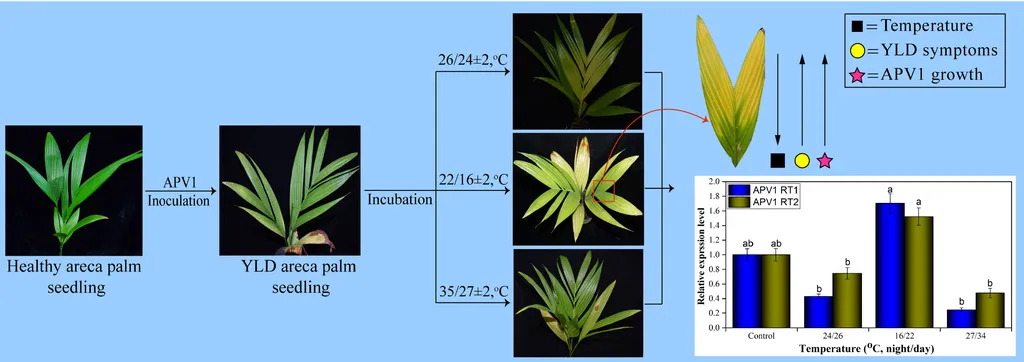In the lush landscapes where Areca palms sway, a silent adversary has long been at play, threatening the yield and quality of a crop vital to the energy sector. Areca palm velarivirus 1 (APV1) has been causing yellow leaf disease, a condition that has puzzled farmers and scientists alike. But a recent study, led by Rui Meng from the College of Tropical Agriculture and Forestry at Hainan University, has shed new light on the molecular mechanisms of this pathogen, potentially paving the way for innovative solutions to protect this economically significant crop.
APV1, a member of the Closteroviridae family, has a genome comprising 11 open reading frames. Among these, ORF6 and ORF7 encode the coat protein (CP) and minor coat protein (CPm), respectively. Meng and his team have identified critical interaction sites between these proteins, a breakthrough that could have significant implications for the energy sector, where Areca palm products are used for biofuel production.
The team employed yeast two-hybrid (Y2H) and bimolecular fluorescence complementation (BiFC) assays to pinpoint the interaction between CP and CPm. Through site-directed mutagenesis, they generated a double mutant (CPR211A−R212A) and found that the residues 211RR212 were key to this interaction. “These residues are crucial for the interaction between CP and CPm,” Meng explained. “Our findings indicate that they play a significant role in symptom formation, making them a potential target for disease management strategies.”
The study also revealed that the CP protein itself is a pathogenic factor, a first in APV1 research. Using the potato virus X (PVX) expression system, the team observed that plants infected with PVX-CP exhibited severe chlorosis symptoms. However, those infected with PVX-CPR211A−R212A showed markedly reduced chlorosis, highlighting the importance of these residues in pathogenicity.
The implications of this research extend beyond the laboratory. Areca palm is a vital crop in many regions, not just for its traditional uses but also for its potential in the energy sector. Understanding the molecular mechanisms of APV1 could lead to the development of more effective disease management strategies, ultimately protecting yield and quality.
As Meng puts it, “This research is just the beginning. By understanding the interaction between CP and CPm, we can start to develop targeted interventions that could mitigate the impact of APV1 on Areca palm crops.”
The study, published in the journal ‘Phytopathology Research’ (translated from Chinese as ‘植物病理学研究’), offers a promising avenue for future research. It not only advances our understanding of APV1 but also opens up new possibilities for protecting a crop that is increasingly important in the global energy landscape. As the world looks towards more sustainable energy sources, the insights gained from this research could play a crucial role in securing the future of Areca palm and, by extension, the energy sector.

